Jed Kolko
@jedkolko.bsky.social
Sr fellow @piie.com. Sr advisor JPMC Institute. Was Under Secretary Econ Affairs at Commerce Dept and chief economist at Indeed and Trulia. Contact at http://jedkolko.com
Methodologies diverge. ADP reflects preliminary benchmark revision, while BLS payrolls won't until Jan 2026. That's extra reason for not drawing conclusions with precision.
ADP as published: -32k
ADP w/o revision: +11k
Plus, must weigh this all against a low breakeven rate!
ADP as published: -32k
ADP w/o revision: +11k
Plus, must weigh this all against a low breakeven rate!

October 1, 2025 at 4:55 PM
Methodologies diverge. ADP reflects preliminary benchmark revision, while BLS payrolls won't until Jan 2026. That's extra reason for not drawing conclusions with precision.
ADP as published: -32k
ADP w/o revision: +11k
Plus, must weigh this all against a low breakeven rate!
ADP as published: -32k
ADP w/o revision: +11k
Plus, must weigh this all against a low breakeven rate!
Update:
The Consumer Expenditure Survey is being delayed ~5 weeks, with no impact on the CPI weights, and for good technical reasons.
The Consumer Expenditure Survey is being delayed ~5 weeks, with no impact on the CPI weights, and for good technical reasons.

September 22, 2025 at 6:34 PM
Update:
The Consumer Expenditure Survey is being delayed ~5 weeks, with no impact on the CPI weights, and for good technical reasons.
The Consumer Expenditure Survey is being delayed ~5 weeks, with no impact on the CPI weights, and for good technical reasons.
The Fed expects slower GDP growth than the White House does -- especially 2026 onward.
One Fed participant projects GDP growth of 2.6-2.7% in 2026, 2027, and 2028, but none projects GDP growth as high as the White House does.
One Fed participant projects GDP growth of 2.6-2.7% in 2026, 2027, and 2028, but none projects GDP growth as high as the White House does.

September 17, 2025 at 6:06 PM
The Fed expects slower GDP growth than the White House does -- especially 2026 onward.
One Fed participant projects GDP growth of 2.6-2.7% in 2026, 2027, and 2028, but none projects GDP growth as high as the White House does.
One Fed participant projects GDP growth of 2.6-2.7% in 2026, 2027, and 2028, but none projects GDP growth as high as the White House does.
Today, Congressional Budget Office lowered its GDP growth projection for 2025 and raised it for 2026. Revision reflects 2025 reconciliation act, tariffs, and lower immigration.
CBO's projections still well below White House assumptions, esp for 2026-2028.
CBO's projections still well below White House assumptions, esp for 2026-2028.

September 12, 2025 at 5:18 PM
Today, Congressional Budget Office lowered its GDP growth projection for 2025 and raised it for 2026. Revision reflects 2025 reconciliation act, tariffs, and lower immigration.
CBO's projections still well below White House assumptions, esp for 2026-2028.
CBO's projections still well below White House assumptions, esp for 2026-2028.
The CPS (household survey) response rate jumped in August to its highest level since last October.
The fog surrounding immigration estimates and survey response rates just keeps getting thicker.
The fog surrounding immigration estimates and survey response rates just keeps getting thicker.

September 5, 2025 at 1:50 PM
The CPS (household survey) response rate jumped in August to its highest level since last October.
The fog surrounding immigration estimates and survey response rates just keeps getting thicker.
The fog surrounding immigration estimates and survey response rates just keeps getting thicker.
Here's the closest it gets to a good-news jobs day chart.
The employment-population ratio, adjusted for population aging, increased slightly in August and remains not far off from a multi-decade high.
The employment-population ratio, adjusted for population aging, increased slightly in August and remains not far off from a multi-decade high.

September 5, 2025 at 1:18 PM
Here's the closest it gets to a good-news jobs day chart.
The employment-population ratio, adjusted for population aging, increased slightly in August and remains not far off from a multi-decade high.
The employment-population ratio, adjusted for population aging, increased slightly in August and remains not far off from a multi-decade high.
The sharp decline in immigration that began mid-2024 and has presumably accelerated in 2025 has not helped the native-born unemployment rate.

September 5, 2025 at 1:18 PM
The sharp decline in immigration that began mid-2024 and has presumably accelerated in 2025 has not helped the native-born unemployment rate.
Job growth has been essentially zero since January in industries that rely more on immigrants.
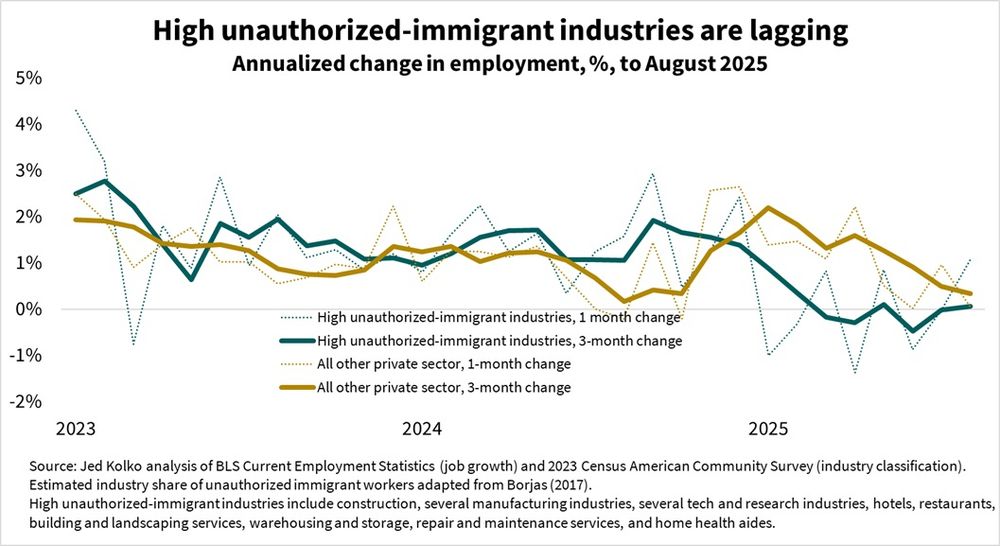
September 5, 2025 at 1:17 PM
Job growth has been essentially zero since January in industries that rely more on immigrants.
Durable goods manufacturing is losing jobs, at an accelerating rate.
That's the sector most directly affected by tariffs. Seems to be hurting.
That's the sector most directly affected by tariffs. Seems to be hurting.

September 5, 2025 at 1:17 PM
Durable goods manufacturing is losing jobs, at an accelerating rate.
That's the sector most directly affected by tariffs. Seems to be hurting.
That's the sector most directly affected by tariffs. Seems to be hurting.
Previewing tomorrow's jobs report:
what we can and can't learn about immigration.
Focus on:
(1) native- and foreign-born unemployment rates
(2) job growth in immigrant-reliant industries.
Ignore pretty much everything else.
jedkolko.substack.com/p/your-guide...
what we can and can't learn about immigration.
Focus on:
(1) native- and foreign-born unemployment rates
(2) job growth in immigrant-reliant industries.
Ignore pretty much everything else.
jedkolko.substack.com/p/your-guide...

September 4, 2025 at 2:03 PM
Previewing tomorrow's jobs report:
what we can and can't learn about immigration.
Focus on:
(1) native- and foreign-born unemployment rates
(2) job growth in immigrant-reliant industries.
Ignore pretty much everything else.
jedkolko.substack.com/p/your-guide...
what we can and can't learn about immigration.
Focus on:
(1) native- and foreign-born unemployment rates
(2) job growth in immigrant-reliant industries.
Ignore pretty much everything else.
jedkolko.substack.com/p/your-guide...
Ahead of jobs day:
Native born unemployment is rising. Foreign born unemployment has fallen below the native born level.
Native born unemployment is rising. Foreign born unemployment has fallen below the native born level.

September 3, 2025 at 2:20 PM
Ahead of jobs day:
Native born unemployment is rising. Foreign born unemployment has fallen below the native born level.
Native born unemployment is rising. Foreign born unemployment has fallen below the native born level.
Monthly job growth has been below breakeven rate for past three months, after July jobs report and downward revisions to payrolls.
I hear this topic might come up at Jackson Hole!
Updated post:
jedkolko.substack.com/p/updated-br...
Original report at @piie.com:
www.piie.com/publications...
I hear this topic might come up at Jackson Hole!
Updated post:
jedkolko.substack.com/p/updated-br...
Original report at @piie.com:
www.piie.com/publications...

August 21, 2025 at 1:53 PM
Monthly job growth has been below breakeven rate for past three months, after July jobs report and downward revisions to payrolls.
I hear this topic might come up at Jackson Hole!
Updated post:
jedkolko.substack.com/p/updated-br...
Original report at @piie.com:
www.piie.com/publications...
I hear this topic might come up at Jackson Hole!
Updated post:
jedkolko.substack.com/p/updated-br...
Original report at @piie.com:
www.piie.com/publications...
In 2025, job growth has accelerated in red states and slowed in blue states.
Acceleration highest in MO, WV, IN, OH, KY.
Acceleration highest in MO, WV, IN, OH, KY.

August 19, 2025 at 3:00 PM
In 2025, job growth has accelerated in red states and slowed in blue states.
Acceleration highest in MO, WV, IN, OH, KY.
Acceleration highest in MO, WV, IN, OH, KY.
US population growth is slowing, more volatile, and harder to estimate than it used to be, mostly due to immigration swings and also population aging.
That will weaken economic growth -- and will make economic statistics less accurate and more prone to revisions.
www.piie.com/publications...
That will weaken economic growth -- and will make economic statistics less accurate and more prone to revisions.
www.piie.com/publications...

August 6, 2025 at 1:34 PM
US population growth is slowing, more volatile, and harder to estimate than it used to be, mostly due to immigration swings and also population aging.
That will weaken economic growth -- and will make economic statistics less accurate and more prone to revisions.
www.piie.com/publications...
That will weaken economic growth -- and will make economic statistics less accurate and more prone to revisions.
www.piie.com/publications...
With today's lower payroll growth number and big downward revisions to May & June ...
Payroll growth has been below the breakeven rate for the last three months.
Payroll growth has been below the breakeven rate for the last three months.

August 1, 2025 at 1:34 PM
With today's lower payroll growth number and big downward revisions to May & June ...
Payroll growth has been below the breakeven rate for the last three months.
Payroll growth has been below the breakeven rate for the last three months.
While we're waiting for the effect of tariffs, the effect of immigration policy has been clear.
Immigrant-dependent industries have grown more slowly than other industries since border encounters dropped in mid-2024, and have been basically flat in 2025.
Immigrant-dependent industries have grown more slowly than other industries since border encounters dropped in mid-2024, and have been basically flat in 2025.
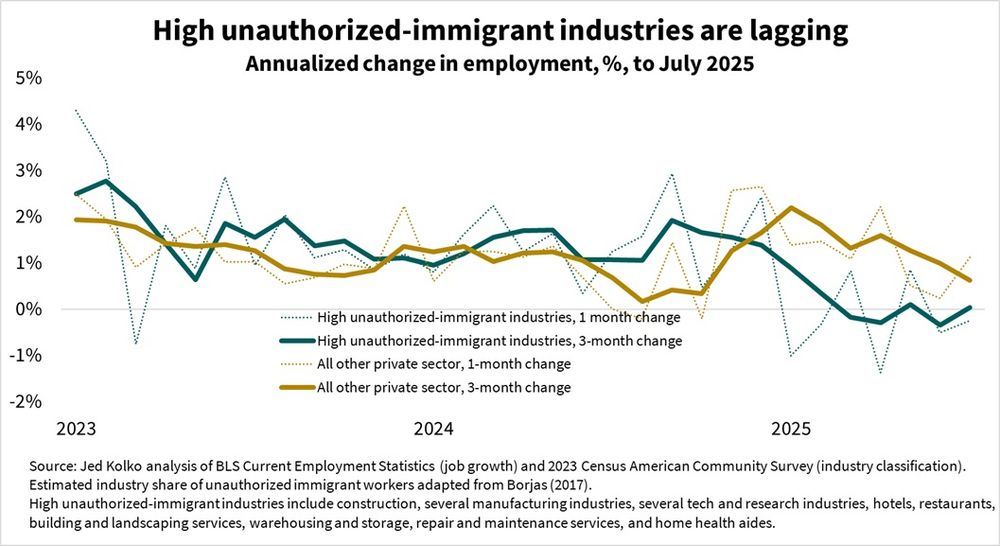
August 1, 2025 at 1:33 PM
While we're waiting for the effect of tariffs, the effect of immigration policy has been clear.
Immigrant-dependent industries have grown more slowly than other industries since border encounters dropped in mid-2024, and have been basically flat in 2025.
Immigrant-dependent industries have grown more slowly than other industries since border encounters dropped in mid-2024, and have been basically flat in 2025.
What's driving slower job growth this year?
Federal government and sectors more dependent on immigration (construction, accommodation/food, etc.).
There's been less of a 2024 vs 2025 shift in manufacturing, which is where to look for the primary effect of tariffs.
Federal government and sectors more dependent on immigration (construction, accommodation/food, etc.).
There's been less of a 2024 vs 2025 shift in manufacturing, which is where to look for the primary effect of tariffs.
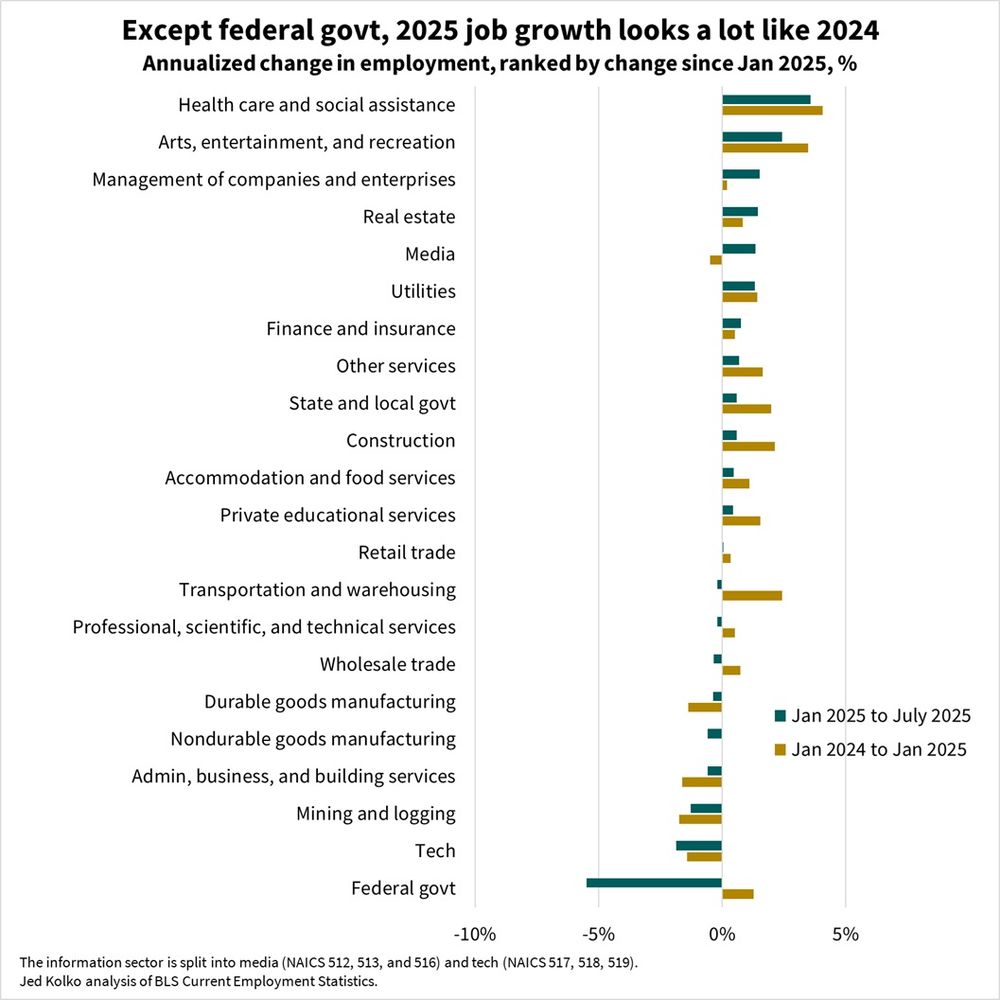
August 1, 2025 at 1:33 PM
What's driving slower job growth this year?
Federal government and sectors more dependent on immigration (construction, accommodation/food, etc.).
There's been less of a 2024 vs 2025 shift in manufacturing, which is where to look for the primary effect of tariffs.
Federal government and sectors more dependent on immigration (construction, accommodation/food, etc.).
There's been less of a 2024 vs 2025 shift in manufacturing, which is where to look for the primary effect of tariffs.
Bigger picture: people are working!
The employment-population ratio (holding age distribution constant) is just slightly below its highest level this quarter-century.
When you hear that [fill in blank] is killing all the jobs, remember this chart.
The employment-population ratio (holding age distribution constant) is just slightly below its highest level this quarter-century.
When you hear that [fill in blank] is killing all the jobs, remember this chart.
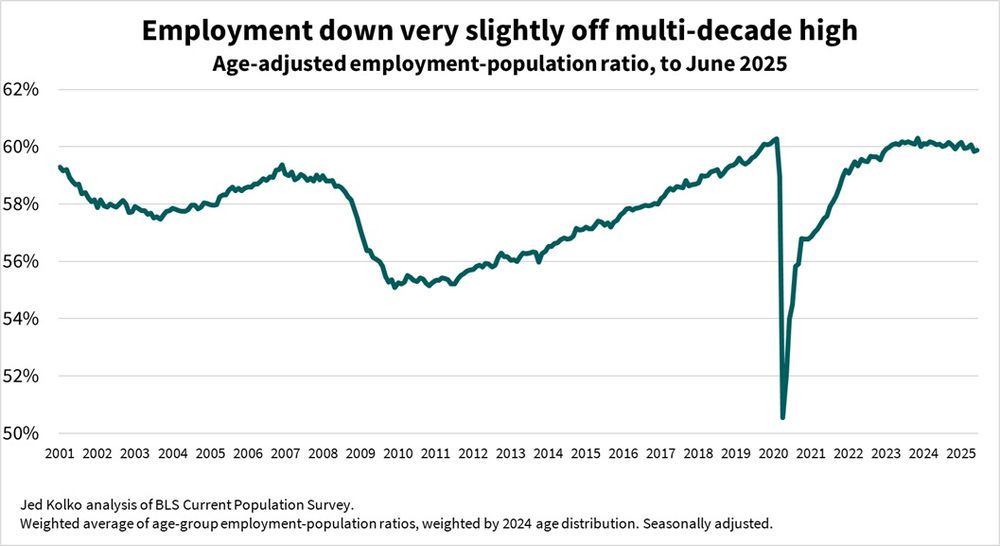
July 3, 2025 at 1:16 PM
Bigger picture: people are working!
The employment-population ratio (holding age distribution constant) is just slightly below its highest level this quarter-century.
When you hear that [fill in blank] is killing all the jobs, remember this chart.
The employment-population ratio (holding age distribution constant) is just slightly below its highest level this quarter-century.
When you hear that [fill in blank] is killing all the jobs, remember this chart.
Job growth lags in industries that rely more on unauthorized immigrants.
Those industries have grown more slowly than other private-sector industries since late 2024.
Those industries have grown more slowly than other private-sector industries since late 2024.
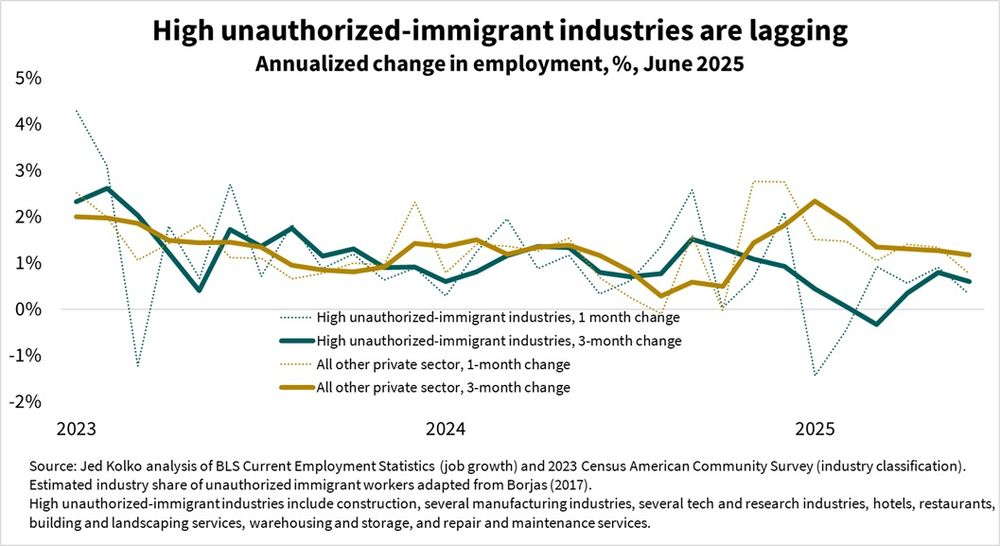
July 3, 2025 at 1:05 PM
Job growth lags in industries that rely more on unauthorized immigrants.
Those industries have grown more slowly than other private-sector industries since late 2024.
Those industries have grown more slowly than other private-sector industries since late 2024.
Federal government and manufacturing lost jobs in June 2025.
Job growth driven by arts & entertainment, state & local government, and health care.
Job growth driven by arts & entertainment, state & local government, and health care.

July 3, 2025 at 1:04 PM
Federal government and manufacturing lost jobs in June 2025.
Job growth driven by arts & entertainment, state & local government, and health care.
Job growth driven by arts & entertainment, state & local government, and health care.
June 2025 payroll growth of +147k was above the breakeven level needed to keep the labor market steady.
Payroll growth have been ahead of breakeven level for 8 months.
Payroll growth have been ahead of breakeven level for 8 months.
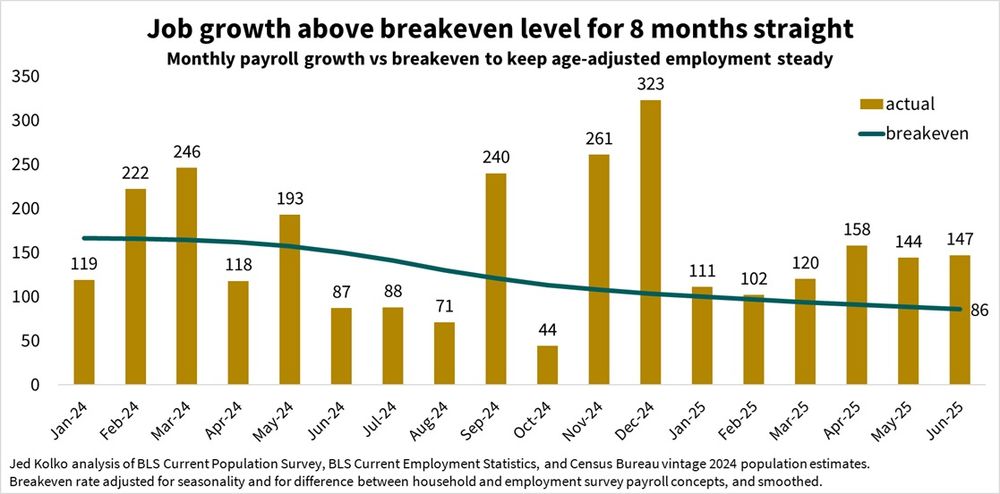
July 3, 2025 at 1:02 PM
June 2025 payroll growth of +147k was above the breakeven level needed to keep the labor market steady.
Payroll growth have been ahead of breakeven level for 8 months.
Payroll growth have been ahead of breakeven level for 8 months.
Payroll growth has been at or above breakeven level for the past seven months, after several months below breakeven in mid-2024.

July 2, 2025 at 12:58 PM
Payroll growth has been at or above breakeven level for the past seven months, after several months below breakeven in mid-2024.
Ahead of tomorrow's jobs report:
The breakeven job level needed to keep employment steady is 87k and falling, down from 165k in 2024.
The immigration surge is over, and peak boomers are aging into retirement.
The bar for a "good" payroll number today is lower than last year.
The breakeven job level needed to keep employment steady is 87k and falling, down from 165k in 2024.
The immigration surge is over, and peak boomers are aging into retirement.
The bar for a "good" payroll number today is lower than last year.

July 2, 2025 at 12:57 PM
Ahead of tomorrow's jobs report:
The breakeven job level needed to keep employment steady is 87k and falling, down from 165k in 2024.
The immigration surge is over, and peak boomers are aging into retirement.
The bar for a "good" payroll number today is lower than last year.
The breakeven job level needed to keep employment steady is 87k and falling, down from 165k in 2024.
The immigration surge is over, and peak boomers are aging into retirement.
The bar for a "good" payroll number today is lower than last year.
The recent sluggishness in manufacturing jobs has been mostly in high-wage manufacturing.
y/y job change:
high-wage manufacturing: -1.7%
all other manufacturing: -0.3%
y/y job change:
high-wage manufacturing: -1.7%
all other manufacturing: -0.3%

June 6, 2025 at 1:21 PM
The recent sluggishness in manufacturing jobs has been mostly in high-wage manufacturing.
y/y job change:
high-wage manufacturing: -1.7%
all other manufacturing: -0.3%
y/y job change:
high-wage manufacturing: -1.7%
all other manufacturing: -0.3%
Updated with May payroll jobs and CPS population numbers:
139k job growth is above today's breakeven level, but below last year's breakeven. Slowing immigration and continued aging means that the bar for a "good" payroll number today is lower than a year ago.
139k job growth is above today's breakeven level, but below last year's breakeven. Slowing immigration and continued aging means that the bar for a "good" payroll number today is lower than a year ago.

June 6, 2025 at 1:20 PM
Updated with May payroll jobs and CPS population numbers:
139k job growth is above today's breakeven level, but below last year's breakeven. Slowing immigration and continued aging means that the bar for a "good" payroll number today is lower than a year ago.
139k job growth is above today's breakeven level, but below last year's breakeven. Slowing immigration and continued aging means that the bar for a "good" payroll number today is lower than a year ago.

